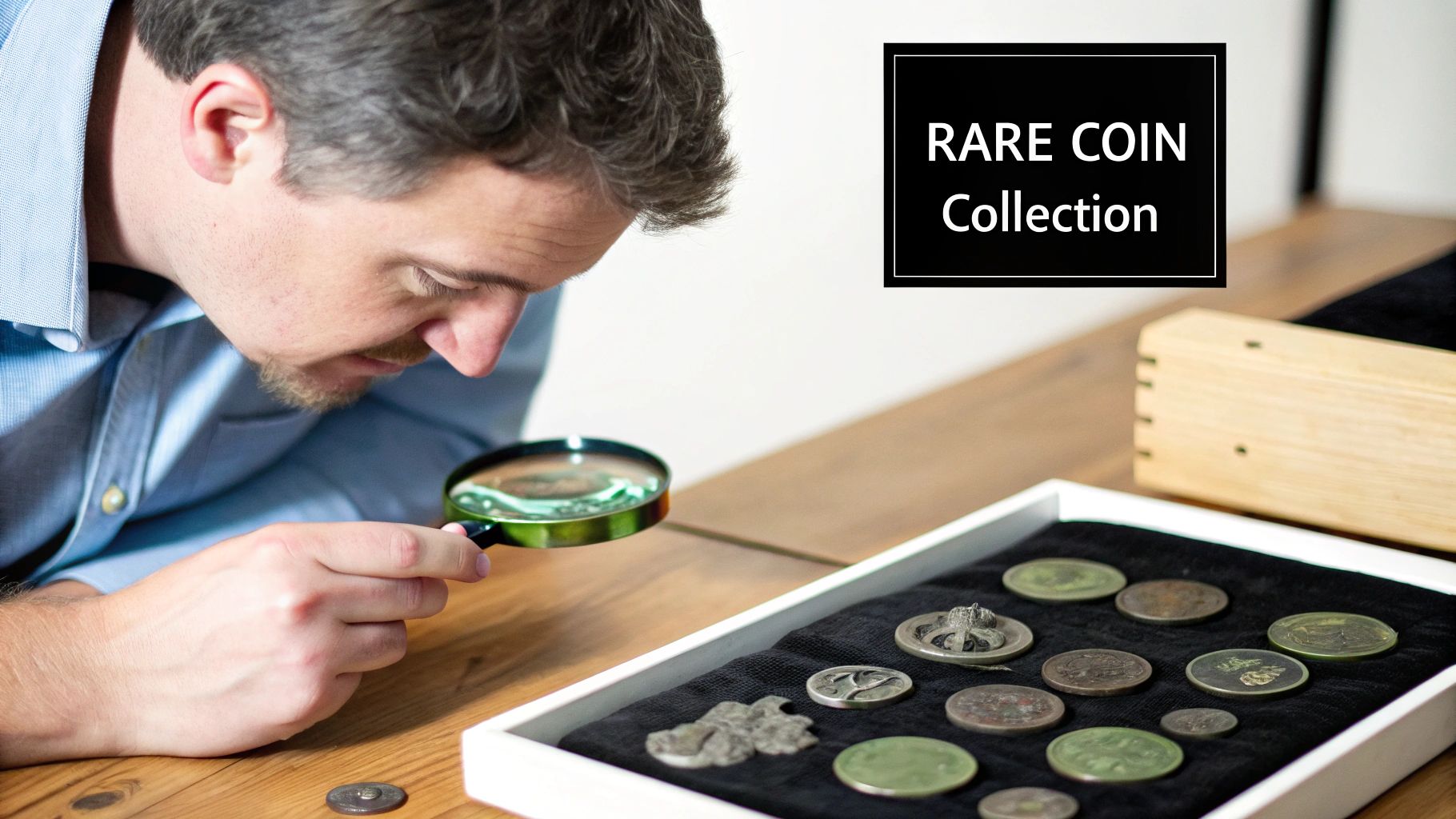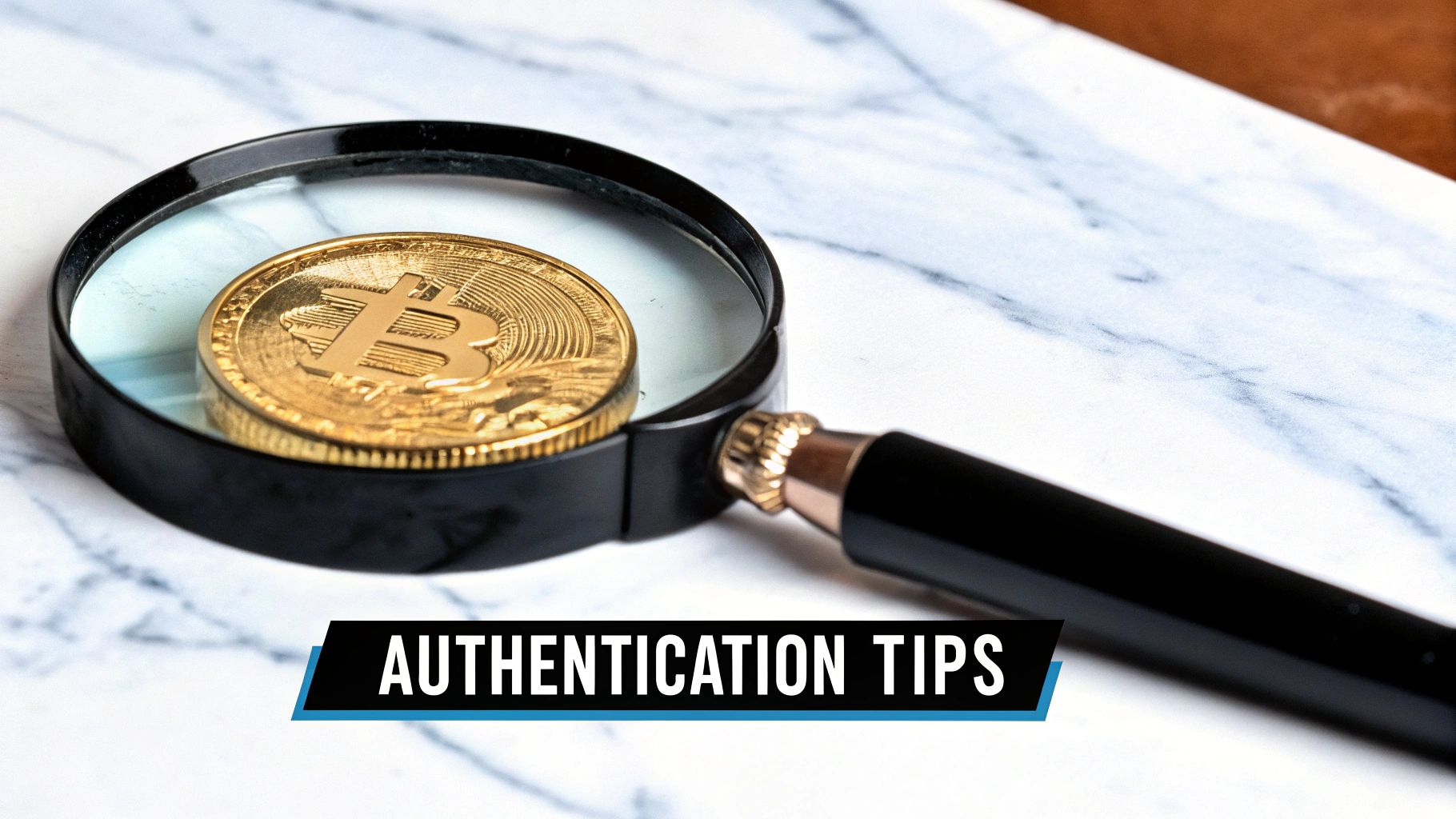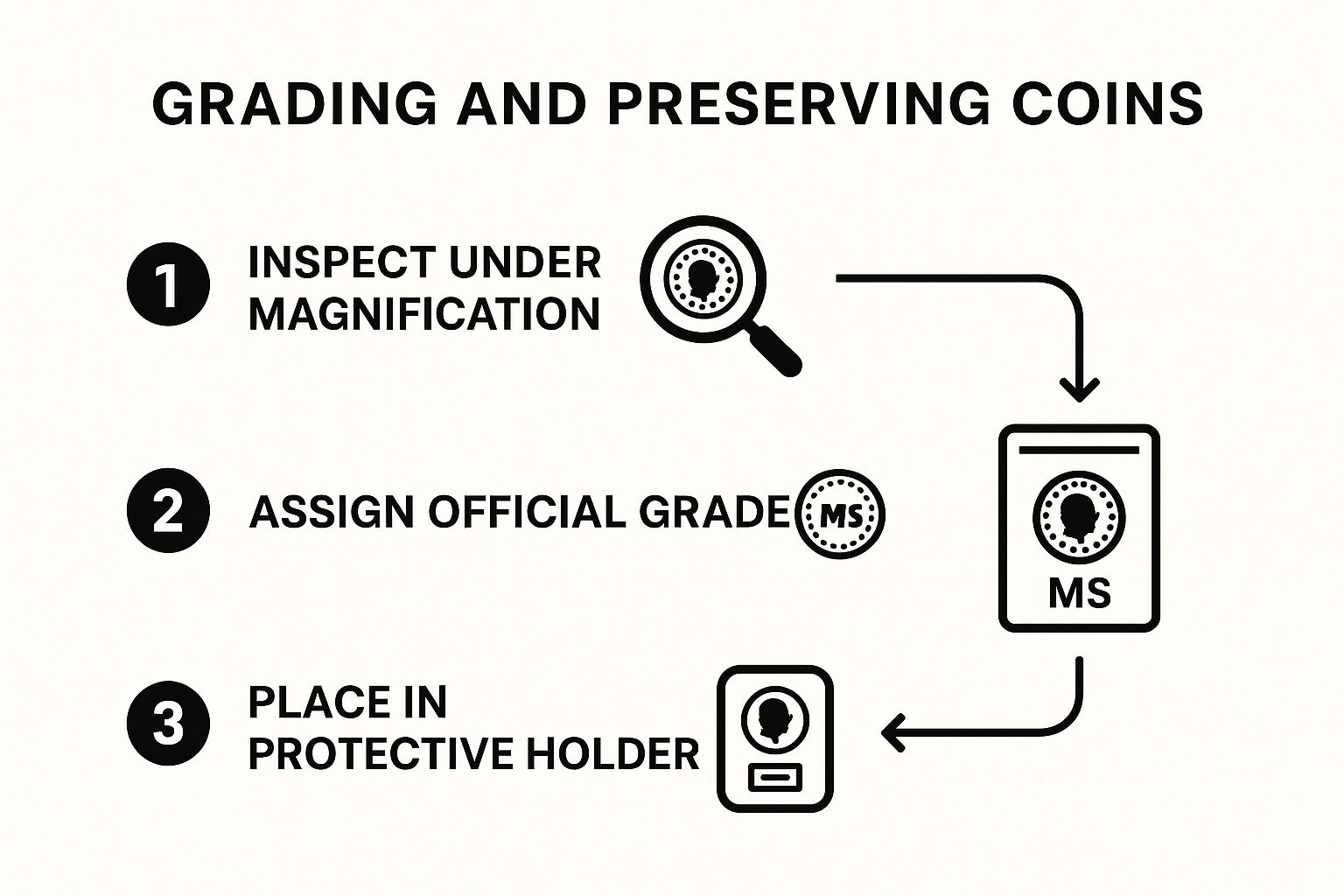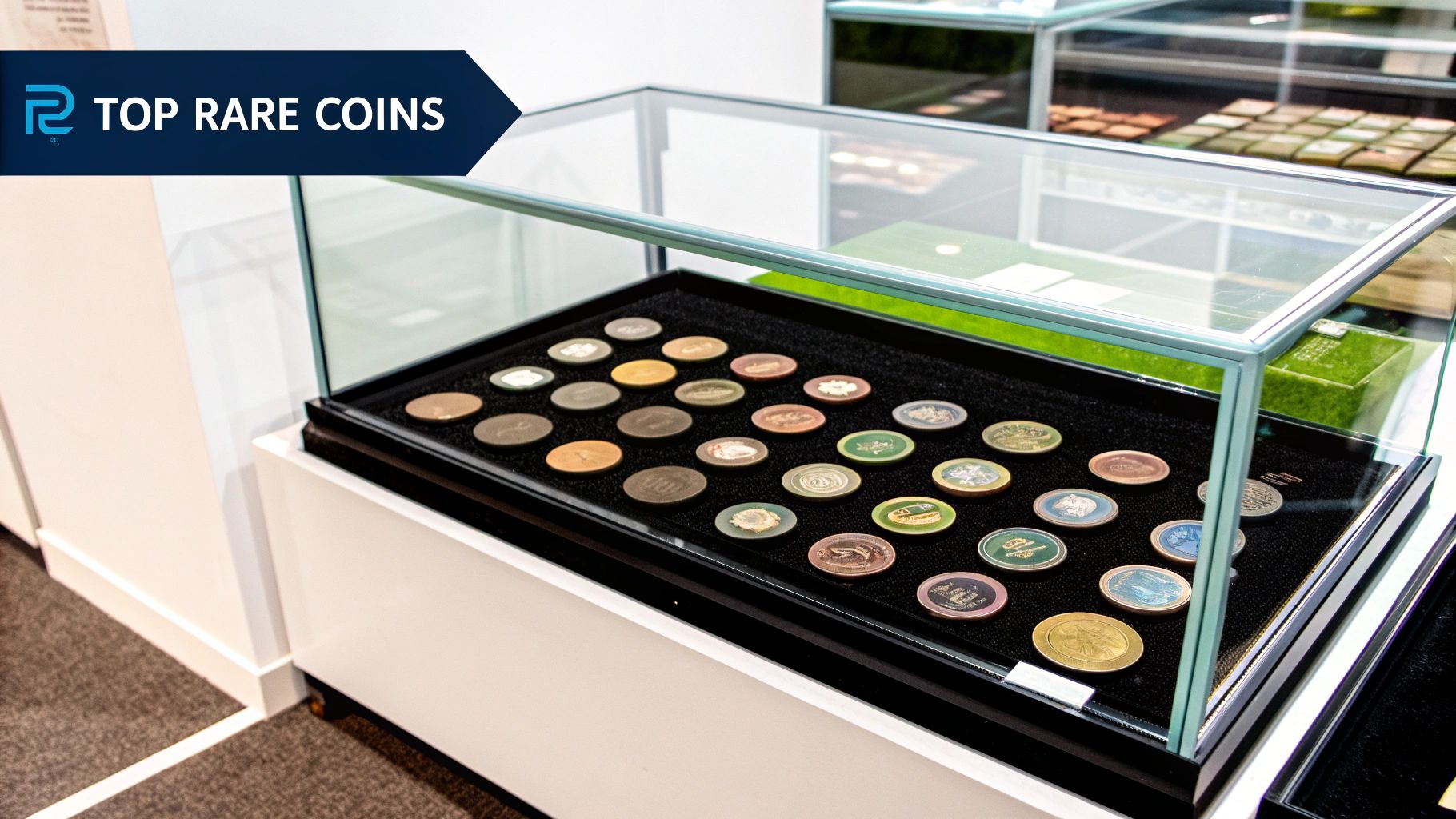For many, collecting rare coins is a fascinating hobby that beautifully merges a love of history with the thrill of finding a hidden gem. It all starts with learning what makes a coin scarce—things like low mintage figures, historical importance, or even unusual errors during minting. Believe it or not, your journey can begin with the loose change you have right now.
Starting Your UK Coin Collecting Journey

Jumping into the world of numismatics is far more accessible than most people think. My own passion was sparked by a simple bag of inherited coins. The challenge of identifying each one was what got me hooked, turning into a lifelong passion. The trick is to move beyond simply gathering old money and start building a collection with real purpose and knowledge.
A successful collection is really a mix of genuine passion and practical know-how. You don't need a massive budget to get started, but you absolutely need curiosity and a few basic bits of kit.
Your Essential First Steps
Before you go hunting for that first major find, make sure you have a couple of essential items. A good quality magnifying glass (with at least 5x magnification) is a must-have for inspecting small details. I'd also strongly recommend a pair of soft cotton gloves to protect coins from the natural oils on your skin, which can cause damage over time.
Next, get to grips with the key things that give a coin its value. Rarity isn't just about how old a coin is; it's often more about scarcity. A modern coin can be incredibly valuable if only a small number were produced.
A perfect example is the 2009 Kew Gardens 50 pence piece. With only 210,000 minted, its scarcity has pushed its value to well over £150 on the secondary market. It's become a cornerstone piece for anyone collecting modern UK coins. If you're looking for a starting point, you can find more details about highly sought-after UK coins to kick off your search.
Collector's Insight: The best and most rewarding collections nearly always come from a personal interest. Whether you’re fascinated by Roman Britain, love the elegance of Victorian silver, or are drawn to modern commemorative coins, picking a theme gives your collection focus and makes the hunt so much more satisfying.
Understanding What Creates Value
To make smart, informed choices, you need to understand the fundamental factors that determine how desirable a coin is. These attributes all work together to build a coin's numismatic profile and, in the end, its market price.
The table below breaks down the core attributes that collectors use to size up any potential addition to their collection.
Key Factors That Determine a Coin's Value
| Factor | Description | UK Example |
|---|---|---|
| Mintage | The total number of coins produced for a specific design and year. Lower is better. | The Kew Gardens 50p's low mintage makes it a modern classic. |
| Condition | The physical state of the coin. An uncirculated coin is far more valuable than a heavily worn one. | An uncirculated Victorian Crown versus one used in trade for decades. |
| Demand | The level of collector interest in a particular coin or series. | High demand for coins from the London 2012 Olympics 50p series. |
Getting familiar with these three pillars—mintage, condition, and demand—is the first real step towards building a collection that is not only personally rewarding but also potentially valuable.
How to Find Your First Collectible Coins
 Once you have a good idea of what you’re looking for, the real fun begins: the hunt for your first truly collectible coins. The brilliant thing about numismatics is that opportunities are literally everywhere. You might find something special in your pocket change, or you could stumble upon a gem in the bustling halls of a dedicated coin fair. It's all about knowing where to focus your attention.
Once you have a good idea of what you’re looking for, the real fun begins: the hunt for your first truly collectible coins. The brilliant thing about numismatics is that opportunities are literally everywhere. You might find something special in your pocket change, or you could stumble upon a gem in the bustling halls of a dedicated coin fair. It's all about knowing where to focus your attention.
The easiest way to dip your toe in the water is a practice collectors call 'coin noodling' or 'coin hunting'. It's the simple, enjoyable act of sifting through your daily change or getting rolls of coins from the bank. You’re looking for those key dates, low mintage issues, and interesting error coins. It costs you nothing but time, and it’s a fantastic way to train your eye.
Sourcing Coins Beyond Your Pocket Change
While finding a treasure in your change is a massive thrill, you'll eventually want to explore more dedicated sources as your collection grows. These avenues open up a world of coins in much better condition than you’ll ever find in circulation.
- Reputable Coin Dealers: A good dealer is probably the greatest asset you can have in this hobby. They offer curated selections and, more importantly, share their expert advice. When you build a good rapport with a dealer, they'll often keep you in mind and offer you pieces they know will be a perfect fit for your collection.
- Coin Fairs and Shows: I can’t recommend these enough. These events bring countless dealers and collectors together under one roof. They are fantastic for seeing a huge variety of coins in person and for networking with people who are just as passionate as you are.
- Online Marketplaces: Websites like eBay can be a goldmine, but you have to be careful. Always stick to sellers with extensive positive feedback and clear, high-quality photos. For more targeted online buying, it's worth checking out our seven tips for buying collectable coins to help you make smarter, safer purchases.
Don't be shy when you approach a dealer. Asking questions about a coin's history (its provenance) shows you're a serious collector and is a great way to learn. Any good dealer will be happy to share what they know.
What to Look For When Hunting
Knowing a coin's mintage figure is absolutely crucial because it directly translates to scarcity. A classic example for UK collectors is the 2011 Edinburgh £1 coin. With a mintage of just 935,000, it's a prime target. Compare that to the Belfast £1 from the same series, which had a mintage of over 6.2 million, and you can see why the Edinburgh issue is so sought-after.
Key Takeaway: Always prioritise buying from trusted sources. Paying a slightly higher price to a reputable dealer is often worth the peace of mind that comes with a guarantee of authenticity. If a deal seems too good to be true, it almost certainly is.
Beyond looking for key dates, train your eye to spot distinctive mint marks (which tell you where a coin was produced) and well-known error coins. These errors can range from misaligned strikes to incorrect lettering, and they can make an otherwise common coin quite valuable. Developing a keen eye for these tiny details is what separates a casual gatherer from a true numismatist.
A Practical Guide to Coin Grading
In the world of rare coins, condition is everything. I can’t stress this enough. A tiny, almost invisible scratch or a slight dulling of the original mint lustre can be the difference between a coin worth £50 and one fetching £5,000. That’s why understanding coin grading is one of the most critical skills you can possibly develop. Think of it as the universal language that helps collectors and dealers agree on a coin's state of preservation and, ultimately, its value.
This isn’t just about sorting coins into "old" or "new" piles. It’s a detailed examination of a coin's surfaces, the quality of its strike, and its overall eye appeal. Every subtle mark tells a story. For instance, tiny parallel scratches known as bag marks—which happen when coins jostle together in mint sacks—are generally seen as more acceptable than post-mint damage, like a deep gash from being dropped.
Decoding UK Coin Grades
At first glance, the descriptive grading scale we use in the UK can seem a bit confusing, but it becomes second nature with practice. The scale covers everything from coins that are barely identifiable to flawless specimens that look as if they just left the Royal Mint. Getting to grips with these terms is your first step towards accurately assessing any potential purchase or even a piece from your own collection.
To make sense of it all, here's a breakdown of the common grading tiers you’ll encounter.
Understanding UK Coin Grading Standards
| Grade | Abbreviation | Key Characteristics |
|---|---|---|
| Poor | P | The coin is heavily worn down. You can just about make out the date and type, but most of the design is gone. |
| Good | G | Most of the design is worn flat, but the main features, legend, and date are visible enough to identify the coin. |
| Very Fine | VF | Shows moderate, even wear on the highest points of the design. Much of the finer detail, however, is still sharp. |
| Extremely Fine | EF | There is only very light wear on the highest features. The coin retains a good portion of its original mint lustre. |
| Uncirculated | UNC | A coin with absolutely no signs of wear. It has never been in circulation but may have some minor bag marks or scuffs. |
| Fleur de Coin | FDC | This is the pinnacle of coin grading. An FDC coin is a perfect, flawless specimen with no marks and full, vibrant mint lustre. |
This table gives you a solid foundation, but there's always more to learn. For a deeper dive into the nuances of each grade, you can read our detailed coin grading guide for beginners and experts, which offers more visual examples to help you train your eye.
The Role of Professional Authentication
While learning to grade your own coins is essential, for anything of significant value, professional third-party grading (TPG) is the gold standard. Companies like the Numismatic Guaranty Company (NGC) and Professional Coin Grading Service (PCGS) provide an unbiased, expert assessment of a coin's grade and, crucially, its authenticity. This adds a layer of security and helps standardise the market for everyone.
This diagram shows the typical workflow for getting a valuable coin professionally graded and protected.
 As you can see, the final step involves encapsulating the coin in a sealed, tamper-proof holder. These are often called "slabs," and they clearly display the grade while guaranteeing authenticity.
As you can see, the final step involves encapsulating the coin in a sealed, tamper-proof holder. These are often called "slabs," and they clearly display the grade while guaranteeing authenticity.
Expert Tip: When you buy a "slabbed" coin, you're not just buying the coin; you're buying the trust and guarantee that comes with that professional grade. This is absolutely vital for valuable items, as it protects you from counterfeits and doctored coins that have been cleaned or repaired to deceive buyers.
How to Value Rare Coins Accurately
Figuring out what a rare coin is actually worth is where the real fun begins. It’s the point where the thrill of the hunt meets the hard numbers of economics. Once you’ve figured out how rare your coin is and have a good handle on its grade, the next step is to nail down its true market value. We’re moving well beyond the number stamped on the coin and into the nuanced world of numismatic pricing, where a whole host of factors come together to decide what a fellow collector is truly willing to pay.
Your most reliable starting point will always be the established price guides. For anyone collecting British coins, a reference book like Spink’s 'Coins of England & The United Kingdom' is absolutely essential. These guides are brilliant for giving you baseline values for different coins across a spectrum of grades, providing a solid foundation for your initial research.
Researching Current Market Prices
But remember, published guides are just that—guides. The coin market is a living, breathing thing. Prices can and do shift based on what collectors are chasing at any given moment and what coins have recently sold for. To get a genuine feel for a coin's current worth, you have to look at what similar pieces are fetching right now.
This means diving into the results of recent auctions from major houses and getting familiar with online marketplaces. Make sure you pay close attention to coins that have been professionally graded, as these offer the most dependable comparisons. You aren’t just looking for one specific price; you’re trying to establish an average range to allow for small differences in condition and that all-important eye appeal. For a much deeper dive, our guide on how to value old coins includes expert tips can help you refine your valuation skills even further.
Key Factors That Influence Final Value
Beyond the basic metrics of rarity and grade, several other elements can have a massive impact on a coin’s final price tag:
-
Provenance: This is the coin's documented ownership history. A piece that was once part of a famous collection or has a well-known story attached to it will often carry a significant premium. It’s the pedigree of the coin.
-
Collector Demand: Some coin series are simply hotter than others. A sudden surge in interest for a particular monarch’s coinage or a specific commemorative issue can send prices soaring.
-
Eye Appeal: This one is more subjective, but it’s absolutely critical. You can have two coins with the exact same technical grade, but they can look worlds apart. A coin with a bold, sharp strike and attractive, original toning will nearly always sell for more.
Case Study in Value: Let's imagine you have a Victorian silver crown from 1889. A price guide might list it at £150 in Extremely Fine (EF) condition. But, after a bit of digging, you find recent auction records showing similarly graded examples consistently selling for over £200. If you can also see that your coin has a particularly strong strike compared to others, you can confidently adjust your valuation upwards.
Sometimes, a coin is so incredibly scarce that its value seems to defy all normal market trends. A fantastic example is the 1993 one penny coin, which was never meant for general circulation. Its legendary rarity means a verified specimen has reportedly sold for an unbelievable price, highlighting just how crucial proper authentication is for a piece like that. You can explore the remarkable story of this modern rarity to see exactly what creates such extraordinary value.
Protecting and Preserving Your Collection

After all the excitement of the hunt, you might be tempted to relax. But this is where the real work begins. Proper storage isn’t just about keeping things organised; it’s a non-negotiable step to protect your coin’s condition and, ultimately, its long-term value.
Think of it this way: you're now the custodian of a piece of history. Your job is to shield it from its natural enemies—humidity, sharp temperature changes, and harmful chemicals. These can cause irreversible damage like corrosion or spotting, which can tank a coin's grade and desirability in a surprisingly short time.
Choosing the Right Storage Materials
Honestly, the biggest mistake I see new collectors make is using the wrong materials for storage. The most notorious culprit is soft PVC (polyvinyl chloride), a plasticiser found in many of those cheap, flexible coin flips and album pages. Over time, PVC breaks down and leaches acidic chemicals, leaving a sticky, green gunk on a coin's surface that's a nightmare to remove without causing more harm.
You absolutely must opt for storage solutions made from inert, archival-quality materials. Here are the most trusted options you can find:
- 2x2 Mylar Flips: These are cardboard holders with windows made from Mylar, a totally inert and safe plastic. They’re affordable, let you write key details on the cardboard frame, and offer solid protection.
- Acrylic Capsules: For your more valuable pieces, these are the gold standard. Hard acrylic capsules create an airtight seal that protects the coin from the atmosphere and any clumsy physical contact.
- Acid-Free Albums: If you love displaying your collection in an album, just make sure the pages and sleeves are explicitly labelled as being acid-free and PVC-free.
- Specialist Coin Cabinets: For serious, high-end collections, wooden cabinets with felt-lined, custom-fitted trays are an elegant and secure solution. Just double-check that the wood and felt have been properly treated so they don't release any damaging fumes over time.
Expert Tip: Never, ever handle your coins with bare hands. The natural oils and acids on your skin can leave fingerprints that will permanently etch into the metal's surface. Always hold coins by their edges and, for best practice, wear soft cotton gloves. It’s a simple habit that makes a world of difference.
Cataloguing and Insuring Your Collection
As your collection grows, keeping a detailed inventory becomes absolutely vital. This isn’t just for your own organisation; it’s a critical requirement if you ever need to make an insurance claim. A simple spreadsheet is all you need to get started.
For each and every coin, you should be recording this information:
| Data Point | Description | Why It's Important |
|---|---|---|
| Coin Identity | Country, denomination, and year. | For basic, at-a-glance identification. |
| Grade | Your own assessment or the official grade if slabbed. | This is the primary factor in determining a coin's value. |
| Purchase Details | Date purchased, who you bought it from, and the price paid. | For tracking your investment and establishing provenance. |
| Photos | Clear photos of both the obverse and reverse. | Provides indisputable visual proof for insurance purposes. |
Once your collection’s value starts creeping past a few thousand pounds, it's time to think seriously about specialist insurance. A standard home contents policy will almost never cover the full numismatic value of rare coins. Specialist policies from providers who understand the collectibles market are worth their weight in gold, offering the comprehensive protection your investment and passion deserve.
Your Coin Collecting Questions, Answered
As you get more into the fantastic hobby of coin collecting, you'll naturally start having questions. It's all part of the journey. To give you a head start and clear up some of the initial hurdles, we've tackled a few of the most common queries we get from collectors here in the UK.
Think of this as a bit of friendly advice from one enthusiast to another.
What’s the Best First Coin for a UK Collector to Buy?
This is a great question, and one we hear all the time. But the best answer isn't a specific coin—it's to pick a theme that genuinely fascinates you. This gives your collecting an immediate sense of purpose and direction. Without a theme, you're just buying randomly; with one, you're building a story.
You could, for instance, decide to build a collection around:
- Pre-decimal shillings: This is a wonderful way to connect with Britain's monetary past, exploring the designs and monarchs that came before decimalisation in 1971.
- Modern commemorative £2 coins: The Royal Mint has issued an incredible range of these bimetallic coins, marking everything from scientific discoveries to historic anniversaries.
When you have a focus like this, the hunt for the next piece becomes so much more rewarding than just chasing a single, high-value coin from the get-go.
Should I Clean My Old Coins?
This is probably the single most important lesson for any new collector, and the answer is almost always a firm no. It's tempting, I know, to want to polish a grimy old coin until it shines, but you must resist.
Cleaning a coin, no matter how carefully, will almost certainly damage it. What you think is dirt is often a coin's patina—a thin layer of toning that develops over decades, sometimes centuries. Serious collectors cherish this patina as proof of the coin's age and originality.
Expert Insight: Cleaning strips away this history and creates tiny, microscopic scratches on the coin's surface. This obliterates its original mint lustre and can slash its numismatic value. An untouched, original coin will almost always be more valuable than one that's been artificially polished.
How Do I Know a Coin I’m Buying Online is Real?
Buying online gives you access to a global marketplace, but it pays to be cautious. Your top priority should be protecting yourself from fakes and coins that aren't what they claim to be. The single best way to do this is to buy only from established, reputable dealers with a history of positive reviews and—this is crucial—a straightforward returns policy. That policy is your safety net.
For any significant purchase, I’d strongly recommend you only consider coins that have been professionally graded and authenticated by a top-tier third-party grading (TPG) service like NGC (Numismatic Guaranty Company) or PCGS (Professional Coin Grading Service). These coins are sealed in a secure, tamper-proof holder (often called a "slab") that guarantees their authenticity and grade. For a high-value coin, this is the ultimate peace of mind.
At Cavalier Coins Ltd, we provide authenticated and accurately graded coins for every level of collector. Explore our extensive selection of rare British and world coins to find the next centrepiece for your collection at https://www.cavaliercoins.com.

